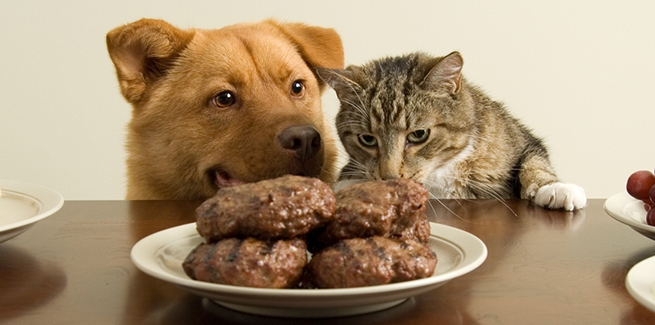"Um . . . you got anything besides meat?"

Raw food diets are rooted in the notion that dogs and cats are carnivores who crave protein and evolved to eat meat.
But is meat what they really want to eat?
Maybe only if it tastes good. A new study shows that when food is altered to remove the appetizing taste, dogs and cats will pass up protein in favor of other macronutrients. Specifically, dogs prefer fat, and cats like carbs.
The study sheds new light on what foods best meet the nutritional needs of dogs and cats, and casts doubt on the popular idea that all cats want and need a protein-heavy diet.
“The numbers were much different than what traditional thinking would have expected,” said the study’s corresponding author, Jean Hall, DVM, MS, PHD, a professor of physiology in the Carlson College of Veterinary Medicine at Oregon State University. “Some experts have thought cats need diets that are 40% or 50% protein. Our findings are quite different than the numbers used in marketing and are going to really challenge the pet food industry.”
Not to mention ruffle proponents of raw food diets for pets.
Hall’s team monitored 17 healthy adult dogs and 27 cats over 28 days and fed them four types of dry pet food that were manipulated to taste the same by changing things such as flavor additives, acidity, and texture. Once researchers removed flavor and texture from the equation, the animals could make macronutrient choices (i.e., protein, carbohydrates, or fat) based only on what their bodies were telling them they needed.
The animals were given a choice of high-fat, high-carbohydrate, high-protein, and balanced foods. The food used in the study, and some financial support, were provided by Hills Pet Nutrition.
Each day, dogs had an hour to eat all they wanted up a predetermined caloric intake. That ensured they could get all the calories they needed to maintain weight while meeting their basic metabolic requirements, but no more.
Cats overeating was less of a concern—even when given unlimited access to tasty food, cats tend to self-regulate by adjusting their food intake based on its energy density—so they had 24 hours to hit their caloric threshold.
Hall and her colleagues found that, on average, the cats chose to get 43% of their calories from carbs and only 30% from protein.
Dogs, however, went for 41% fat and 36% carbs.
Significantly, not a single dog or cat chose to get the highest percentage of their calories from protein.
Age and body mass played a role, which led the researchers to hypothesize that there was a physiological basis for what the animals chose to eat: Younger, leaner cats ate more protein than older, heavier cats; and younger, leaner dogs ate less protein than older, heavier dogs.
Basically, the researchers think that both dogs and cats were instinctively eating what their bodies were telling them they needed most in terms of nutrition.
And it wasn’t protein.
NEWStat asked corresponding author Hall to comment on the study’s implications for raw food diets.
Hall said, “The data shows that no dogs or cats showed the biological drive to eat as much protein as fed in most raw foods.” She also pointed out that there is no peer-reviewed data to support the long-term benefit for “raw” or “natural” foods. Moreover, Hall said , “Foods such as those fed in this study have been shown to meet all the requirements for complete and balanced nutrition.”
Hall added, “Optimum nutrition is of course different, and we have shown that such nutrition includes not only appropriate protein, fat, fiber, and minerals but enhanced fatty acids, antioxidants, and phytochemicals found in fruits and vegetables.”
So next time you’re thinking of feeding your pet a raw food dinner, you might want to hold the hamburger.
AAHA discourages feeding a raw protein diet to family pets due to the health risks not just to the pets but to the family. Read AAHA’s position statement on raw protein diets here.
Photo credit: © iStock/WebSubstance



